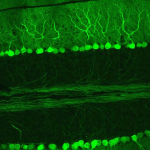Implications of the BPF small mammal brain preservation prize, from the prosaic to the profound
Keith Wiley
Author of A Taxonomy and Metaphysics of Mind-Uploading
Brain Preservation Foundation fellow
Feb. 10, 2016
On February ninth, the Brain Preservation Foundation (BPF) announced the winner of its small mammal prize for the successful preservation of a rabbit brain (See https://www.brainpreservation.org/small-mammal-announcement/). For a little more than a year I have had the privilege of serving as an advisor to the BPF, whose primary purpose has been to manage a prize similar to “X prizes” for other technological innovations, this one in the area of brain preservation techniques (which notably requires peer-reviewed publication of the contributing work so as to vet the success in the broader research community). There were two candidate techniques for the prize, a cryogenic method pioneered by Rob McIntyre at 21st Century Medicine (21CM) and a room-temperature method pioneered by Shawn Mikula at the Max Planck Institute. It was a remarkably close race, especially in light of the fact that the two competing techniques are quite different in their underlying approach. One operates at cryogenic temperatures, essentially improving upon established methods by which tissue may be brought to ultra-low temperatures while attempting to mitigate the problems imposed by the formation of water ice crystals. The other method relies on a completely different approach in which the brain is chemically preserved and then embedded in plastic, essentially locking its structures in place without the need for low temperatures. It is fairly surprising that two dramatically different methods could come to fruition at nearly the same time. Although one officially won the prize, we can take this close timing as an indication that there will soon be not one, but two notably diverse options available for the long term preservation of brains. This diversity is, of course, good news since each method may offer advantages over the other for various applications.
In its most prosaic form, the advantages may align with current cryogenic applications. 21CM, the company where McIntyre did his research, is already in the business of cryogenically preserving organs for transplantation (e.g., corneas, skin grafts, cartilage, etc.). One potential consequence of the successful preservation of a brain is simply the indication that cryogenic techniques in general are steadily improving. Therefore, we can take the achievement of the brain preservation prize as indicative of the likely improved application of cryogenics in medicine in general. In other words, perhaps we can soon preserve yet more organs which have not been amenable to such procedures in the past, perhaps even in life-saving ways. While this is admittedly a somewhat speculative prediction since McIntyre’s procedure uses deadly chemicals, we can nevertheless say his team’s achievement certainly breaks new ground in working with biological tissues, and furthermore it is accompanied by other research concerning advances directly in the fields of hibernation and organ preservation (see references below).
Another area that may improve as a result of winning the preservation prize is basic research. It is notoriously difficult to study brains because they contain sophisticated three-dimensional structure, yet quickly diffuse into a veritable goo soon after death. These traits challenge attempts at investigation. While less precise cryogenic techniques have been around for some time, and while more precise techniques have been available at very small scales (fractions of a millimeter), the new techniques offer ways to study the preserved large-scale structure of a brain in ways never before possible. The opportunity to “slice-and-scan” brains that have been preserved in this manner should enable new areas of study in the topology of neural networks (i.e., connectomes) and other aspects of brain structure. From that research, new insights should subsequently follow into the network algorithms that brains use to process information, store memories, and generally perform all the processes that brains perform. In short, new advances in the preservation of brains enable new advances in the dissection and study of brains.
Let us now consider some of the more theoretical possibilities. Cryonics is the application of cryogenic techniques to the preservation of whole persons (or sometimes just their heads) with the intent of reviving them at a future time. Existing cryonics protocols clearly do not rely on the revolutionary method pioneered by McIntyre’s research. More critically, only one half of the cryonic equation (the preservation half) has even been approached; subsequent revival remains totally elusive. While there are currently numerous cryonically preserved patients held by a small number of private companies around the world, we clearly have no way to revive these people. Even worse, there is significant concern that the current protocols may not adequately preserve the salient information of the brain: even if revivification methods were available, currently preserved brains might have been irreparably damaged during preservation. So while McIntyre’s technique preserves brain structure with far greater detail than past techniques, we still have no conceivable means to reverse any cryogenic process in mammals.
To make matters worse, McIntyre’s method is, in some ways, more problematic than older methods. His solution to preserving greater detail relies on brutal chemicals which actually do more harm from a survival perspective than older cryonics techniques. It’s a toss up. Older techniques are less poisonous but likely fail to adequately preserve brain structure, while the new technique preserves the necessary structure, but only by lethally poisoning the biological system in the process. Only future research could resolve whether either method might eventually be reversible. I am dubious on both counts frankly.
Mikula’s technique, which competed closely for the prize, offers a similar advantage while suffering a similar setback. Once perfected, Mikula’s room-temperature chemical-preservation-and-plastic-embedding process will also preserve spectacular structural detail, far beyond that achieved by conventional cryogenic preservation, but this procedure utterly precludes any hope of future biological revival. Mikula’s technique will be tremendously useful toward brain studies of course, but as far as life extension is concerned, plastic embedding could only conceivably proceed by a completely different for more controversial approach: mind uploading.
This brings us to the most speculative implication of the winning of the brain preservation prize. Whether by McIntyre’s cryogenic technique or by Mikula’s chemical-and-plastic technique, there then arises the tantalizing, albeit utterly futuristic (and philosophically unresolved) prospect of mind uploading, in which a mind is disassociated from its brain to continue on in another physical system. On the theory that the brain encodes all traits crucial to the representation and instantiation of the mind, some philosophers have asked whether a mind might be scanned from its associated brain to be reinstantiated in another physical system. This process is call mind uploading (or whole brain emulation) and, while doubtlessly utterly speculative in our current era, resides entirely within the boundaries of physicalist and functionalist theories of mind. Consequently, if such theories of mind and their associated theories within philosophy survive in the future, then we might use brain preservation techniques as one step in various forms of mind uploading procedures—someday.
It may turn out that none of the current brain preservation techniques can be successfully reversed to revive the biological organism. Current established protocols are suspect for their failure to preserve sufficient detail, while McIntyre’s technique relies on harsh and lethal chemicals (and Mikula’s utterly precludes biological reversal). If no preservation method capable of capturing the required detail can be reversed, we will be left with only one course of action as far as attempts to extend life are concerned. Mind uploading, at least for those people who can adopt the necessary philosophical stance that such a procedure would preserve personal identity and/or represent personal survival, will be the only option left, speculative or not.
On this last point, when the philosophical fires are stoked, there are many positions to hold. Some readers won’t consider the possibility at all, dismissing any hope that a preserved brain could be revived by any means. For those who grant that a sufficiently detailed preservation might house the person, some readers will still insist that only biological revival is of any hope, that any notion of mind uploading via a structural scan could not render an operating brain and mind. Yet further along, some readers may allow that mind uploading techniques could yield a thinking person, but not one who would be conscious, commonly known as a philosophical zombie. A step further along the philosophical spectrum allows that uploaded individuals will be fully revived persons, but only as some form of doppelganger of the original. These readers state that the original person died and some other person arose in their place. This argument is often summarized with the refrain “it’s just a copy.” Finally, we arrive at the extreme position along the philosophical spectrum of possibilities regarding mind uploading, that a preserved brain can be successfully scanned and reinstantiated not only to render a living, conscious person, but furthermore in a way best characterized as an unequivocal preservation of identity with the status of personal survival. I have written copiously on these questions and encourage curious readers to consider my arguments on the matter, cited below.
Whatever the future may hold, the achievement of improved brain preservation techniques will surely play some role. For that we should all be exhilarated by the achievement of this prize. Congratulations to all the participants, and good luck in their future work.
References
Cerullo M. Uploading and branching identity. Minds and Machines, 25(1):17–36. 2015.
Guibert E. et al. Organ preservation: current concepts and new strategies for the next decade. Transfusion Medicine and Hemotherapy, 38(2):125–142. 2011.
McIntyre R. and Faye G. Aldehyde-stabilized cryopreservation. Cryobiology, 71(3):448–58. Dec 2015.
Mikula S. and Denk W. High-resolution whole-brain staining for electron microscopic circuit reconstruction. Nature Methods, 12:541–546. 2015.
Ratigan E. and McKay D. Exploring principles of hibernation for organ preservation. Transplantation Reviews, 30(1):13–19. 2016.
Wiley K. A Taxonomy and Metaphysics of Mind-Uploading. Humanity+ Press and Alautun Press. 2014.
Wiley K. and Koene R. The fallacy of favoring gradual replacement mind uploading over scan-and-copy. Journal of Consciousness Studies. 2016 (in press).









Great article Keith. I am one of those who tend to accept mind uploading as a conceptually viable means to preserve personal identity (with just one little caveat below) and therefore I look forward to the availability of “cryonics for uploaders” options. To those who don’t like the idea of living as disembodied software in a virtual world, or in the circuitry of a hard metallic robot, I suggest to consider this: mind uploading – which requires first reading the huge amount of connectome data in the preserved brain, and then bringing the data to life in a “me-program” running on a suitable hardware and software system – is likely to be significantly harder than extreme bionics and bio-engineering. Therefore, by the time mind uploading is available, we are very likely to have also the means to grow a biological body and a biological brain similar to the original (or better), and upload the connectome to the new brain. I guess I would prefer to live as pure software, but others will be the option to continue life in a wetware body.
My only caveat: Perhaps Hameroff and Penrose are right, and quantum physics plays a strong fundamental role in how the brain’s wetware generates consciousness. If consciousness depends critically on subtle quantum aspects of our neural circuitry, not present in silicon electronics, then we wouldn’t be able to upload a mind to a silicon computer. If so, we will have to develop alternative substrates that exhibit the key quantum properties found (actually not yet found) in carbon-based biology. That wouldn’t make mind uploading impossible, just harder. But there is the possibility that the new brain preservation technology doesn’t capture the structure of the brain at the (presumably smaller) scale at which the relevant quantum effects operate.
However, the current scientific consensus is that non-quantum physics should be sufficient to model the brain-mind system.
Dr. Wiley’s statement,
“So while McIntyre’s technique preserves brain structure with far greater detail than past techniques, we still have no conceivable means to reverse any cryogenic process in mammals…. Mind uploading, at least for those people who can adopt the necessary philosophical stance that such a procedure would preserve personal identity and/or represent personal survival, will be the only option left, speculative or not.”
is incorrect. As noted by the Brain Preservation Foundation, near the bottom of
https://www.brainpreservation.org/21cm-aldehyde-stabilized-cryopreservation-eval-page/
the ASC technique used by McIntyre, including the fixative, was first proposed in 1986 in the specific context of cryonics followed by in situ repair and biological revival. The technique proposal and outline for reversal was made by none other than Eric Dexer, the father of molecular nanotechnology, in his book, Engines of Creation.
http://e-drexler.com/d/06/00/EOC/EOC_Chapter_9.html
The reversal process for fixation and vitrification is described in two pages, but the technology for it is explained in Drexler’s 1981 Proceedings of the National Academy of Sciences paper and 500 pages of his MIT PhD thesis, later published as the book, Nanosystems. So not only was a means conceived for reversing the technique used by McIntyre, but it was a means for biological revival, not anything as radical as mind uploading. To say that there is no conceivable means to reverse fixation and vitrification is to deny both the history of the idea and what is theoretically possible as outlined. Mind uploading is a newcomer to the history of fixation and vitrification, not the only future for it.
Destructive scanning to some level of still-unknown detail by still-undeveloped technologies, followed by synthesis of a replacement biological brain or uploading into an alternative substrate, is indeed also a conceivable revival scenario for minds within brains that have been chemically fixed. For that matter, it’s also a conceivable revival scenario for minds within cryopreserved brains that were not chemically fixed. Depending on the level of molecular detail required, it may yet turn out that so-called mature molecular nanotechnology is both necessary and sufficient for revival irrespective of fixation status or desired revival method (assuming adequate preservation). Right now scanning/uploading technology, preservation technology, and biological repair technology are still so primitive that revival methods (uploading vs. repair) and preservation methods (cross-linking vs. not cross-linking) are practically orthogonal axes.
On such matters, I believe someone such as Kenneth Hayworth would be better equipped to address your concerns in detail. What I can say though, at the least, is that any conceptual description of a revival process resides squarely at the initial theory level. Nothing approaching a full revival has actually been performed in the lab yet. On that we should be able to agree. Perhaps Ken can offer deeper insight on this question.